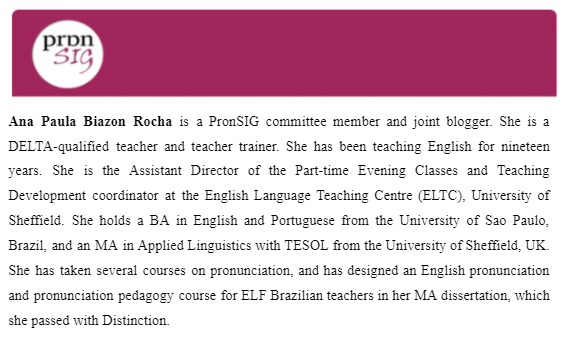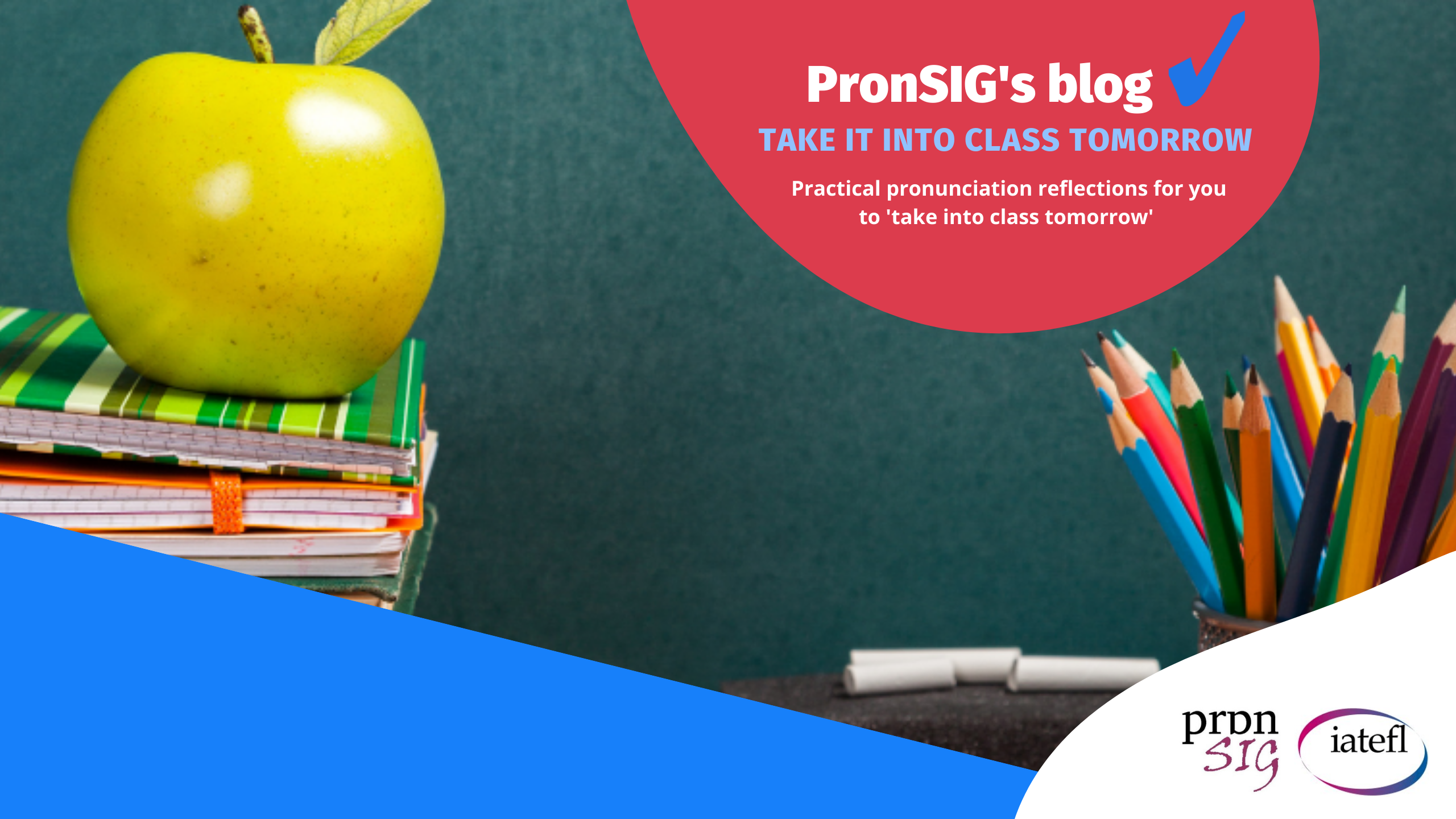by Ana Paula Biazon Rocha
In most course books, especially in lower levels, -ed endings in past regular verbs are a recurrent example of how to integrate pronunciation into lessons. The practice of this grammar point tends to be an opportune moment to draw students’ attention to the different possible pronunciation forms: /t/, /d/, or /ɪd/, worked, loved, invited/needed, respectively. Everybody benefits from this: publishers can claim they do focus on pronunciation in their materials, teachers feel they are doing their part, in other words, they are teaching pronunciation in their lessons, and learners can improve pronunciation, right?… Well, I dare to ask: and then what? What does learning that -ed endings can be pronounced as /t/, /d/, or /ɪd/ really mean to learners? How will this piece of information help them in their real-life exchanges in English?
To answer that, let’s take some steps back and try to retrace how the teaching of -ed endings in past verb forms usually works:
1. There is usually some input to introduce past regular verbs: a dialogue, possibly with an audio track, a paragraph or a story, a song, a video, etc. From it, some verbs are extracted as examples.
2. By using the examples extracted, the teacher explains the main differences among the three possible pronunciation forms, preferably demonstrating how to distinguish voiceless and voiced consonant sounds with the vibration of the throat, such as in this video:
a. after voiceless consonants /t/, e.g., worked
b. after voiced consonants /d/, e.g., loved
c. after t and d /ɪd/, adding an extra syllable, e.g., invited, needed
3. Then, there is often a chart for learners to group the verbs provided according to the -ed ending:
| /t/ | /d/ | /ɪd/ |
| worked | loved | invited needed |
4. After that, students can listen and repeat the verbs in the chart, as well as some sentences that contain some of the verbs in the chart.
For an example of this sequence (1-4), check Hewings (1993, p. 76-7, exercises 1-4).
Sometimes the order can be changed: a) the chart can be given to students right after the input, b) they try to group the regular verbs according to the correct pronunciation, c) then they identify the /t/, /d/, or /ɪd/ pronunciation pattern, d) the teacher demonstrates how to identify voiceless and voiced consonant sounds, e) students listen and repeat the verbs or sentences. For an example of this sequence (a-d), check Smolder (2012, p. 62-3, Listen and Focus on form).
5. Some practice on identifying present or past tense verbs can also be added at this point. Students listen to an audio track and choose the correct verb, for example:
“I laugh / laughed at his joke”.
For an example of this, check Hancock (2012, p. 57, exercise 24.4).
6. Finally, more practice can be provided through:
- a rhyme (Hancock, 2012, p. 56, exercise C).
- an odd one out exercise (Baker & Goldstein, 2008, p. 108, exercise C).
- a song.
- a poem (Marks, 2007, p. 95, exercise 43.4).
- a game.
However, there is more to the pronunciation of –ed endings.The next step is to add a clear communicative purpose: in real-life conversations, learners must recognise that within connected speech, past regular verbs, or any other word for that matter, are not normally pronounced in isolation, for example, “loved /lʌvd/”, but in a stream of speech, “I loved_it /aɪ lʌvdɪt/!” Thus, it is essential to show students that in connected speech, different things can happen to the pronunciation of -ed endings:
- they may be linked to the initial sound of the next word: ‘I love-dit /lʌvdɪt/ (final consonant sound + initial vowel sound).
- they may be linked to the initial sound of the next word: ‘You looked tired (/t/ + /t/ = look-tired) yesterday’
- final /t/ or /d/ may be elided because of the next initial consonant sound: ‘I loved that (lov-that) cake’.
Without explicit instruction drawing learners’ attention to these features, they may struggle to identify and understand them in conversation with others. The idea here is to focus on receptive skills first because that is what students need: they should be able to understand what their interlocutor(s) is/are saying in the conversation in order to react / reply to it accordingly. Second, there can be some focus on students producing some of these features. However, it really depends on your learners’ needs and objectives, and having them practise connected speech could be used as another way to make them better at recognising it, that is, better listeners. For more on this, check Hancock (2022).
To practise the pronunciation of -ed endings in connected speech, the teacher can
- give learners a list of sentences where they should link the -ed ending to the next word (Grant, 2017, p. 35, exercise 12), for example:
“I walked_into the wrong room”.
- have students practise linking sounds in phrasal verbs through a maze (Hancock, 2017a, p. 26, Corner to Corner: Version 6), for instance:
“cried_out”, “mixed_up”, tried_on”, etc.
- have students practise reading a poem (Hancock, 2017b, p. 55, 4.14 Lost).
- have students sing a song (Hancock, 2020, p. 50, 5.13, Life for Gold).
The final step could include:
- asking students to talk about what they did last week by focusing on past regular verbs.
- giving them a picture and asking them to imagine what happened/create a story based on it.
- having students play ‘Two truths and a lie’ using past regular verbs: students think of two true statements and a false one, tell them to their partner, who tries to guess what is true and what is false (Grant, 2017, p. 36, exercises A-D), for example:
- Some time ago I played_on a professional volleyball team. (Lie)
- Yesterday I asked_Thomas to help me with my homework. (Truth)
- Last night I dreamed_about travelling to France. (Truth)
- The sky’s the limit!
In this way, pronunciation practice becomes communication practice. To put it simply, it should not just be about learning the pronunciation of -ed endings for the sake of learning it, but for a purpose, for something that will help them improve their English, especially in terms of recognising and understanding the language in real-life communication.
Clearly, if it is not possible to follow all these steps in one lesson, they can be divided into several. They should also be adapted to learners’ needs, context and level, from lower levels (A2, B1) to even higher ones (B2, C1).
How about you? How do you usually teach the pronunciation of -ed endings in past regular verbs?
For more tips, ideas and discussions on pronunciation teaching, please check our previous blog posts, and spread the word. Don’t forget to follow PronSIG on social media and leave your comments below.
References
Baker, A. & Goldstein, S. (2008). Pronunciation Pairs. An Introduction to the Sounds of English. Student’s Book. Cambridge University Press.
Grant, L. (2017). Well Said. Pronunciation for Clear Communication. Fourth Edition. National Geographic Learning.
Hancock, M. (2012). English Pronunciation in Use Intermediate. Second Edition. Cambridge University Press.
Hancock, M. (2017a). PronPack 2: Pronunciation Puzzles. Hancock McDonald ELT.
Hancock, M. (2017b). PronPack 4: Pronunciation Poems. Hancock McDonald ELT.
Hancock, M. (2020). PronPack 5. Pronunciation of English for Spanish Learners. Hancock McDonald ELT.
Hancock, M. (2022). PronPack: Connected Speech for Listeners. Hancock McDonald ELT.
Hewings, M. (1993). Pronunciation Tasks. A Course for Pre-Intermediate Students. Student’s Book. Cambridge University Press.
Marks, J. (2007). English Pronunciation in Use Elementary. Cambridge University Press.
Smolder, C. M. (2012). Be understood! A pronunciation resource for every classroom. Cambridge University Press.



The ‘Marks, 1995, p.95, Ex 43.4’ ref is missing from the above. Can I please receive this?
Hello Jane.
I’ve just amended it. Apologies for the late reply. As you can you see above, the correct reference is:
Marks, J. (2007). English Pronunciation in Use Elementary. Cambridge University Press. P. 95. Exercise 43.4.
I’m always extremely careful with references in our blog posts. This one must’ve slipped.
Many thanks for warning me and for reading our blog.
Best,
Ana.
Belated thanks Ana. Much obliged!
Jane